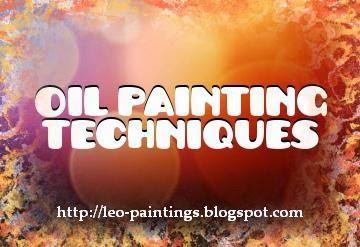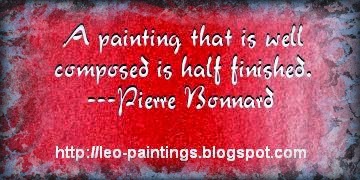1)Blocking color.
Block in color with diluted brush strokes by following the outlines of an object. This allows you to define the edges of the object without using the thicker paint. The key is to outline the edges of the object with the same colors that will be used inside of it.
2) Instant background.
You can use a painted background as the base of the painting. Use diluted paint applied in small strokes. Sketch or draw over this base color for an instant background.
3) Transparency.
When showing the transparency of an object in the painting, apply opaque colors over the top of transparent colors.
4) Using layers.
Oil painting allows the artist to completely paint over and completely cover other paint layers as long as they are dry. If you plan on using multiple layers, start out with thinner layers of paint in lighter colors. Slowly make your way toward thicker layers and darker colors.
5) Intensify colors.
Dilute the paint to various stages to create contrast that will intensify the colors. Different densities of the same color can be used to better define the form. When using this technique, leave the background color for last. The diluted surface of the background contrasts with the denser surface of the object.
6) Contrasting colors.
Contrast the colors in your piece to create a three-dimensional feeling.
7) White paint.
In monochromatic subjects you can add volume and relief by emphasizing the white tones. To do this, apply white paint thickly over the base color. Do not over brush the white paint into the object. The brush marks and shades should be easy to see.
8) Chiaroscuro.
Chiaroscuro is one of the oldest oil painting techniques for bringing volume to an object. It focuses on the movement of light across the surface of the object through light and dark contrasting. When using this technique, shadows should be completely black and it is best to use a neutral background color. Learn more about chiaroscuro in famous works with this art history course on Renaissance to 20th century art.
9) Value of brush strokes.
Brush strokes can also define the volume and shape of an object. Use your brush like you would a pencil. Apply different colors of paint like you would with colored pencils.
10) Charcoal lines.
Use charcoal lines behind an object to reinforce it’s shape and give it dimension.
11) Saturated color.
Using saturated color is the most direct way to add form and volume. To use this technique, saturate the color as much as possible in areas of the object that are not illuminated.
12) Brush stroke size.
Different sizes of brush strokes can be used to define and differentiate planes, masses, objects and different areas of the painting. Try experimenting with longer brush strokes, short jabs, and even tiny dots. In general, smaller brush strokes will represent objects closer in the foreground.
13) Paint mixture irregularities.
Add a textual effect to your painting by leaving streaks of color in your paint mixture. These irregularities can add interest to your piece.
14) Foliage.
When painting foliage, your brush strokes can represent leaves. Vary the tones of the leaves by adding more or less diluted paint. Learn more about painting foliage with this plein air (painting outdoors) painting course.
15) Pointillism.
For an Impressionist look to your painting, try using this technique of pointillism. This consists of dabbing small quantities of paint systematically across the entire canvas to achieve a uniform and continuous texture.
16) Informal brush strokes.
Try using informal brush strokes that do not follow a pattern and run in different directions. These strokes should cover the canvas in fluid bunches of color. This technique can be used with both thick and diluted paint.
17) Nonrepresentational brush strokes.
Use a brush stroke free of representational obligations. This means the strokes can go outside of the lines of the object being defined. The strokes will create both the drawing and the color at the same time.
18) Soft texture.
Create a soft feeling in your object with blurred and irregular brush strokes. Try rubbing the brush against the support to get a fluffy texture.
19) Transparent glass.
To suggest the consistency of crystal or transparent glass, keep your paint color pure and add strategic contrast. Add the dark contrasting colors last to suggest the density.
20) Metal.
To create the effect of shiny metal, you must contrast black against white. Paint the darkest areas of the object with diluted black and then apply some diluted white along the black brushstrokes to blend. Apply touches of pure white last to highlight the reflections on the metal.
21) Monochromatic.
Try creating a monochrome painting. Pick a color based on the wide variety of shades it can make. The different intensities of the color will be determined by the dilution of the paint.
22) Cool colors.
Try working with only cool colors like that greens, grays, and blues. Use just a little bit of warm colors to create a counterpoint in the piece.
23) Complementary colors.
The main complementary colors are yellow and violet, blue and orange, and red and green. When these colors are mixed they create gray but when they are next to each other, they create a stark contrast. Consider using complementary colors in your work.
24) Skin.
Human skin does not have a specific color. Artist use combinations and different harmonies of colors to create human flesh. Try using mostly warmer colors with a touch of cool colors to achieve this look.
25) Landscape shadows.
When painting shadows in landscapes, use cool colors like blues, violets, purples, and grays. If you are interested in learning more about oil painting continue your education with a class on oil painting techniques and color theory.


No comments:
Post a Comment